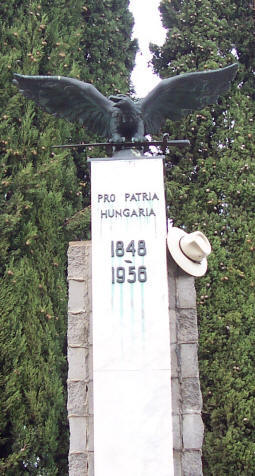Troubles on the other side of the world

The monument to Hungarian patriots seems to make reference to things that
happened a long time ago in a place far away. In reality it is partly there
because of events which happened only a generation and several suburbs away.
In 1956 Melbourne was hosting the Olympic Games. A number of teams came
to Melbourne early to acclimatise. This included the Hungarian Water Polo
Team � then reigning Olympic Champions � who arrived to the news that Soviet
tanks had rumbled into Budapest to stamp out attempts to create a democracy.
Tensions were high and numbers of Hungarian competitors swore they would not
return to a Russian-dominated Hungary. This was all a bit strange and
confronting for Melburnians. Ever since the days of the gold rush people had
the basic understanding that you leave you guns and knives and old enmities
from other times and places at the door. True, there had always been a few
troubles from the old countries which raised their head. There was the
attempt to reproduce the Irish troubles in early Melbourne but the results
were almost comical rather than disruptive. From time to time a new arrival
would lob a fire bomb into the club of a rival ethnic group, but after a
while things usually settled down as people realised that here was a chance
to make a break from the centuries-old resentments and feuds.
But here was Melbourne in 1956 with distant troubles brought to its
doorstep and with the possibility of disrupting the Olympic Games. This came
to a head when Hungary and Russia competed in the semi-finals of the water
polo. Competed is perhaps not the correct word. The current charter of the
pool where both teams trained (only several hundred metres away from the
monument) claims to
provide �a safe swimming experience for all abilities�. The Hungary-Russia
water polo match was not a safe swimming environment. There was warfare in
the pool from beginning to end. When a Hungarian competitor was king hit
towards the end and the crowd looked as though they could riot, officials
ended the match prematurely.
With tension mounting about what could happen at the closing ceremony
with countries marching under their own flags, it took the lateral thinking
of an Australian schoolboy to provide a solution. He suggested that athletes
should all mix and march together without country groupings � a practice
which has been followed to this day.
The monument to Hungarian patriots was erected soon after those Olympic
Games. It refers not just to the 1956 uprising but various patriotic
uprisings over the centuries. Most people walk past thinking it refers to
events far away in another time. However I occasionally sit there and ponder
the blood in the pool not far away, and one Australian school child who,
rather than chanting slogans and taking sides was able to look at things in
a different way.
|
|
Copyright © 1995 - 2025
White Hat.
|
Other articles in the series Seven Monuments of Melbourne: